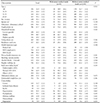References
1. Bennett AC, Rankin KM, Rosenberg D. Does a medical home mediate racial disparities in unmet healthcare needs among children with special healthcare needs? Matern Child Health J 2012;16Suppl 2. :330–338.
2. Newacheck PW, Stoddard JJ, Hughes DC, Pearl M. Health insurance and access to primary care for children. N Engl J Med 1998;338(8):513–519.
3. Jeong HS. Korea's National Health Insurance--lessons from the past three decades. Health Aff (Millwood) 2011;30(1):136–144.
4. Shin YJ, Shon JI. The prevalence and association factors of unmet medical need-using the 1st and 2nd Korea welfare panel data. Health Soc Welf Rev 2009;29(1):111–142.
5. Ahn YH, Kim NH, Kim CB, Ham OK. Factors affecting unmet healthcare needs of older people in Korea. Int Nurs Rev 2013;60(4):510–519.
6. Alonso J, Orfila F, Ruigómez A, Ferrer M, Antó JM. Unmet health care needs and mortality among Spanish elderly. Am J Public Health 1997;87(3):365–370.
7. Herr M, Arvieu JJ, Aegerter P, Robine JM, Ankri J. Unmet health care needs of older people: prevalence and predictors in a French cross-sectional survey. Eur J Public Health 2013;24(5):808–813.
8. Kim YS, Lee J, Moon Y, Kim KJ, Lee K, Choi J, et al. Unmet healthcare needs of elderly people in Korea. BMC Geriatr 2018;18(1):98.
9. Kim YS, Han SH, Lee JM, Shin G, Choi JK, Park JM. Senior friendly hospital: a new paradigm for the hospital-based care of the elderly. Korean J Clin Geriatr 2017;18(1):8–14.
10. Pappa E, Kontodimopoulos N, Papadopoulos A, Tountas Y, Niakas D. Investigating unmet health needs in primary health care services in a representative sample of the Greek population. Int J Environ Res Public Health 2013;10(5):2017–2027.
11. Choi SH, Cho YT. Sex differentials in the utilization of medical services by marital status. Korea J Popul Stud 2006;29(2):143–166.
12. Park EA, Lee IS. Factors affecting the depression of the elderly women in poverty. J Agric Med Community Health 2009;34(2):256–266.
13. Im EO, Meleis AI. A situation-specific theory of Korean immigrant women's menopausal transition. Image J Nurs Sch 1999;31(4):333–338.
14. Fried LP, Tangen CM, Waltson J, Newman AB, Hirsch C, Gottdiener J, et al. Frailty in older adults: evidence for a phenotype. J Gerontol A Biol Sci Med Sci 2001;56:M146–M156.
15. Hoogendijk EO, Muntinga ME, van Leeuwen KM, van der Horst HE, Deeg DJ, Frijters DH, et al. Self-perceived met and unmet care needs of frail older adults in primary care. Arch Gerontol Geriatr 2014;58(1):37–42.
16. Chen J, Hou F. Unmet needs for health care. Health Rep 2002;13(2):23–34.
17. Diamant AL, Hays RD, Morales LS, Ford W, Calmes D, Asch S, et al. Delays and unmet need for health care among adult primary care patients in a restructured urban public health system. Am J Public Health 2004;94(5):783–789.
18. Hwang BD, Choi R. The prevalence and association factors of unmet medical needs by age group in the elderly. Korean J Health Serv Manag 2015;9(1):81–93.
19. Moon J, Kang M. The prevalence and predictors of unmet medical needs among the elderly living alone in Korea: an application of the behavioral model for vulnerable populations. Health Soc Welf Rev 2016;36(2):480–510.
20. Hwang J. Understanding reasons for unmet health care needs in Korea: what are health policy implications? BMC Health Serv Res 2018;18(1):557.
21. Allin S, Grignon M, Le Grand J. Subjective unmet need and utilization of health care services in Canada: what are the equity implications? Soc Sci Med 2010;70(3):465–472.

